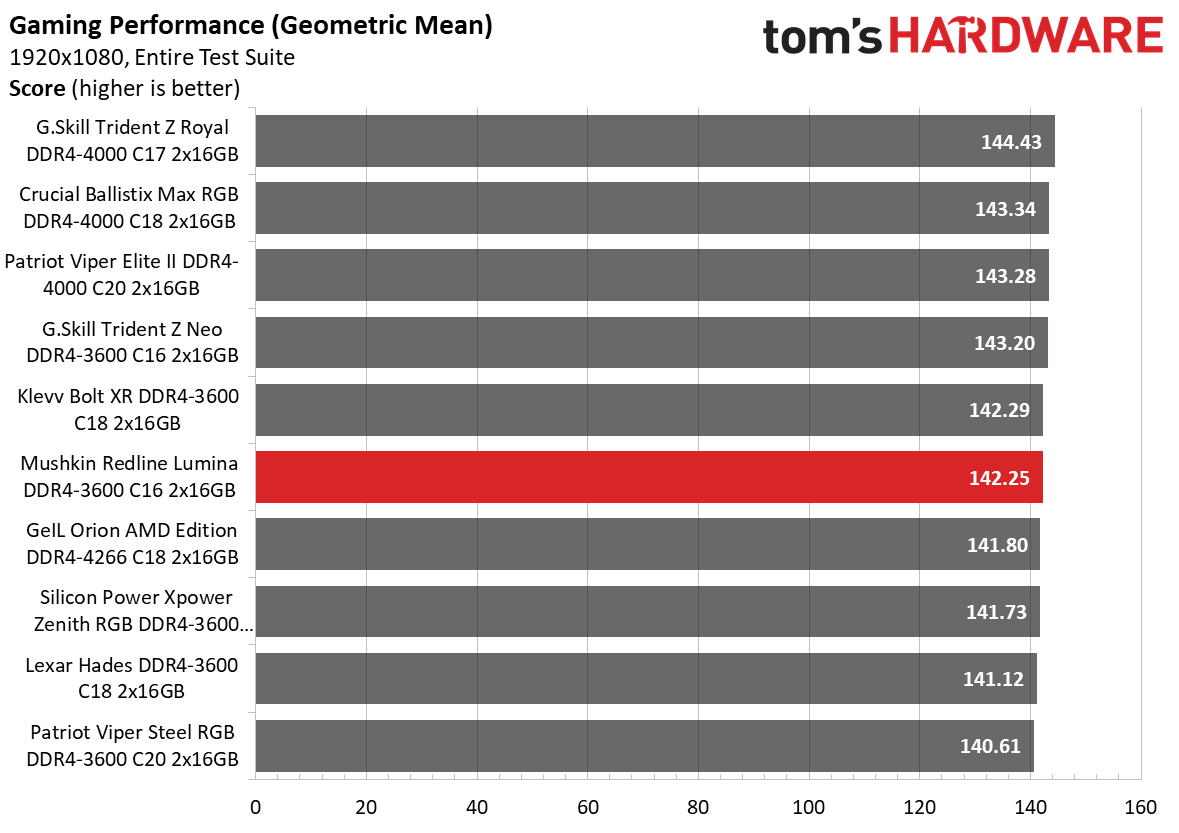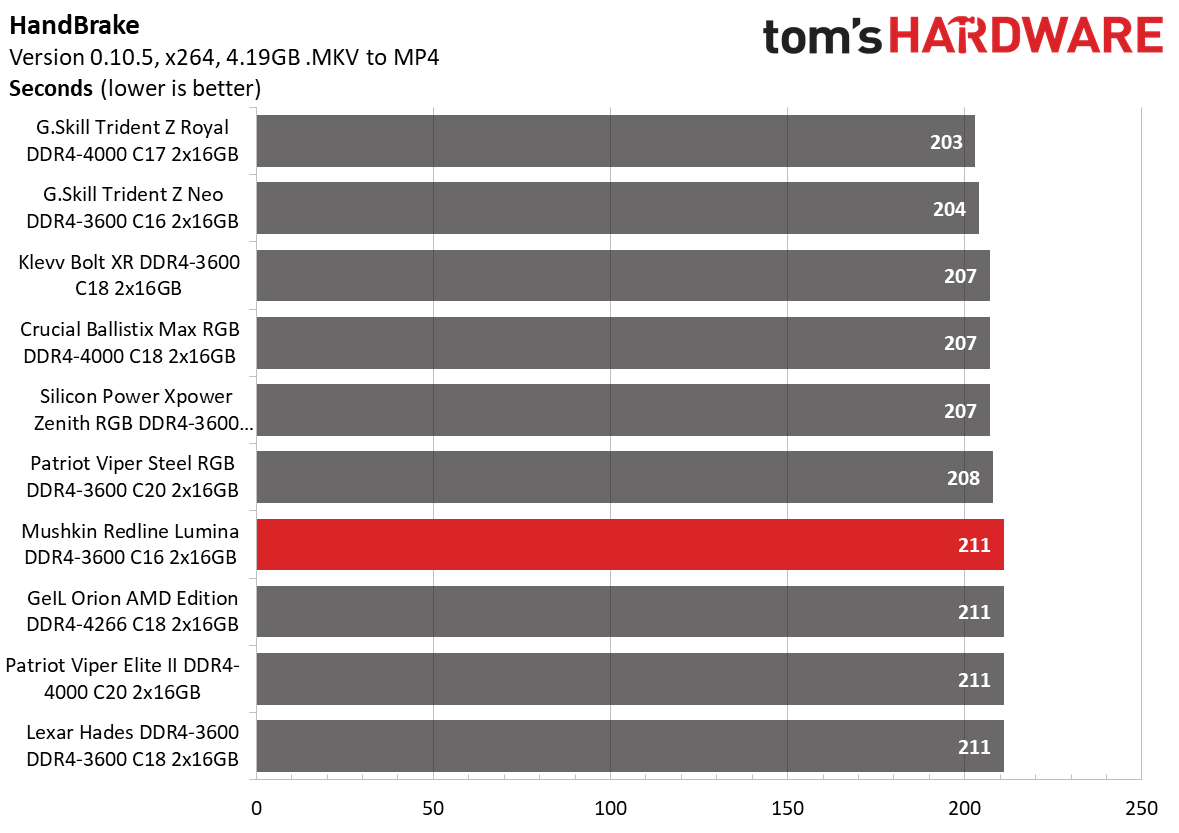Tom's Hardware Verdict
The Redline Lumina DDR4-3600 C16 kit suffers from a single-rank design, putting it at a disadvantage against conventional 32GB (2x16GB) dual-rank memory kits.
Pros
- +
+ Good aesthetics
- +
+ Overclocking headroom
Cons
- -
Single-rank design
- -
High XMP voltage
- -
Pricey
Why you can trust Tom's Hardware
Admittedly, Mushkin had been absent from the memory game for a bit. Make no mistake, though, the brand is one of the veteran memory vendors, and now it's getting back into the game with a new series of DDR4 memory kits. The Redline Lumina lineup is designed for the latest Intel and AMD platforms with capacities spanning 16GB (2x8GB) to 64GB (2x32GB) and frequencies up to DDR4-4133, positioning Mushkin is to compete with the best RAM on the market.



Redline Lumina memory modules have a black PCB with a matching aluminum heat spreader. In addition, a silver strip with a diamond cut edge pattern helps highlight the heat spreader's black exterior. Unsurprisingly, the memory modules pridefully carry the Mushkin, Redline, and Lumina logos.
The Redline Lumina is very compact, measuring 37.5mm (1.48 inches) tall, so we don't the Redline Lumina having any problems fitting underneath CPU air coolers. In addition, Mushkin offers users two ways to control the Redline Lumina's RGB illumination. You can use the included Mushkin RGB software or your motherboard's software. The memory is compatible with Asus Aura Sync, ASRock Polychrome, Gigabyte RGB Fusion, and MSI Mystic Light.
Each memory module is 16GB and features a single-rank design and an eight-layer PCB. Thaiphoon Burner couldn't detect the type of integrated circuits (ICs) Mushkin uses for the Redline Lumina DDR4-3600 C16. However, given the single-rank design, we suspect that the company is likely employing Micron ICs.
The Redline Lumina defaults to DDR4-2666 at 19-19-19-43. XMP 2.0 support is present; however, there's only one profile. The DDR4-3600 profile sets the timings to 16-19-19-39 and 1.4V. It's not a life-threatening voltage, but it will certainly put enthusiasts on edge, especially for a DDR4-3600 memory kit with loose timings. For more on timings and frequency considerations, see our PC Memory 101 feature, as well as our How to Shop for RAM story.
Comparison Hardware
| Memory Kit | Part Number | Capacity | Data Rate | Primary Timings | Voltage | Warranty |
|---|---|---|---|---|---|---|
| GeIL Orion AMD Edition | GAOR432GB4266C18ADC | 2 x 16GB | DDR4-4266 (XMP) | 18-24-24-44 (2T) | 1.45 Volts | Lifetime |
| G.Skill Trident Z Royal | F4-4000C17D-32GTRGB | 2 x 16GB | DDR4-4000 (XMP) | 17-18-18-38 (2T) | 1.40 Volts | Lifetime |
| Crucial Ballistix Max RGB | BLM2K16G40C18U4BL | 2 x 16GB | DDR4-4000 (XMP) | 18-19-19-39 (2T) | 1.35 Volts | Lifetime |
| Patriot Viper Elite II | PVE2432G400C0K | 2 x 16GB | DDR4-4000 (XMP) | 20-26-26-46 (2T) | 1.40 Volts | Lifetime |
| G.Skill Trident Z Neo | F4-3600C16D-32GTZN | 2 x 16GB | DDR4-3600 (XMP) | 16-16-16-36 (2T) | 1.35 Volts | Lifetime |
| Mushkin Redline Lumina | MLA4C360GKKP16GX2 | 2 x 16GB | DDR4-3600 (XMP) | 16-19-19-39 (2T) | 1.40 volts | Lifetime |
| Klevv Bolt XR | KD4AGU880-36A180C | 2 x 16GB | DDR4-3600 (XMP) | 18-22-22-42 (2T) | 1.35 Volts | Lifetime |
| Silicon Power Xpower Zenith RGB | SP032GXLZU360BDD | 2 x 16GB | DDR4-3600 (XMP) | 18-22-22-42 (2T) | 1.35 Volts | Lifetime |
| Lexar Hades | LD4BU016G-R3600UDLH | 2 x 16GB | DDR4-3600 (XMP) | 18-22-22-42 (2T) | 1.35 Volts | Lifetime |
| Patriot Viper Steel RGB | PVSR432G360C0K | 2 x 16GB | DDR4-3600 (XMP) | 20-26-26-46 (2T) | 1.35 Volts | Lifetime |


The Intel system employs the Intel Core i9-10900K and Asus ROG Maximus XII Apex, which operates on the 0901 firmware. On the opposite side, the AMD system consists of the AMD Ryzen 9 5900X and the Asus ROG Crosshair VIII Dark Hero. The latter is on the 3501 firmware. The MSI GeForce RTX 2080 Ti Gaming Trio takes care of the graphical RAM benchmarks, such as gaming.
| Header Cell - Column 0 | Intel System | AMD System |
|---|---|---|
| Processor | Intel Core i9-10900K | AMD Ryzen 9 5900X |
| Motherboard | Asus ROG Maximus XII Apex | Asus ROG Crosshair VIII Dark Hero |
| Graphics Card | MSI GeForce RTX 2080 Ti Gaming X Trio | MSI GeForce RTX 2080 Ti Gaming X Trio |
| Storage | Crucial MX500 500GB, 2TB | Crucial MX500 500GB, 2TB |
| Cooling | Corsair Hydro H115i Pro | Corsair Hydro H115i Pro |
| Power Supply | Corsair RM650x 650W | Corsair RM650x 650W |
| Case | Streacom BC1 | Streacom BC1 |
Intel Performance



















The memory kit ranged from second to last on the Intel application performance chart. The memory was only faster than the GeIL Orion AMD Edition DDR4-4266 C18. In terms of gaming performance, the memory kit landed in the middle of the pack.
Get Tom's Hardware's best news and in-depth reviews, straight to your inbox.
AMD Performance



















The Redline Lumina didn't take off on the AMD platform, either. Nonetheless, the memory kit improved its position just a little bit. It performed the best in the Microsoft Office workload where it was only behind the fastest memory kit by a hair.
Overclocking and Latency Tuning

Mushkin's memory kit hit a wall at DDR4-4100, which was very respectable for a DDR4-3600 memory kit. It already draws 1.4V at XMP, therefore, we upped the voltage to 1.45V for some headroom. It was easy getting to DDR4-4100, too. All we had to do was bump the CAS Latency (CL) from 16 up to 17 cycles.
Lowest Stable Timings
| Memory Kit | DDR4-3600 (1.45V) | DDR4-3800 (1.45V) | DDR4-4100 (1.45V) | DDR4-4133 (1.45V) | DDR4-4200 (1.45V) |
|---|---|---|---|---|---|
| G.Skill Trident Z Neo DDR4-3600 C16 | 13-14-14-35 (2T) | N/A | N/A | N/A | 19-19-19-39 (2T) |
| Klevv Bolt XR DDR4-3600 C18 | 16-19-19-39 (2T) | N/A | N/A | 18-22-22-42 (2T) | N/A |
| Mushkin Redline Lumina DDR4-3600 C16 | 16-17-17-37 (2T) | N/A | 17-19-19-39 (2T) | N/A | N/A |
| Patriot Viper Steel RGB DDR4-3600 C20 | 16-20-20-40 (2T) | 17-26-26-46 (2T) | N/A | N/A | N/A |
While the Redline Lumina was impressive in our overclocking tests, it wasn't very cooperative when we tried tightening its timings. At DDR4-3600 and 1.45V, the CL wouldn't go lower than 16 cycles. However, the tRCD, tRP and tRAS worked fine at 17-17-37.
Bottom Line
Single-rank 16GB memory modules are becoming more and more common nowadays. It's a shame because both Intel and AMD processors benefit from four memory ranks, which means putting at least two 16GB dual-rank memory modules together. The performance hit from single-rank DIMMs isn't overly significant in some cases, but it's clearly visible in the performance charts.
Due to its single-rank design, the Redline Lumina DDR4-3600 C16 simply couldn't compete with its dual-rank rivals even if they had inferior memory timings, such as the Klevv Bolt XR DDR4-3600 C18. Mushkin's memory kit is available through Amazon with a $199.99 price tag, so it's on the pricier side. The Redline Lumina DDR4-3600 C16 might be worth your consideration if you fall for its aesthetics or find it on sale. Otherwise, it's hard to justify the purchase.

Zhiye Liu is a news editor, memory reviewer, and SSD tester at Tom’s Hardware. Although he loves everything that’s hardware, he has a soft spot for CPUs, GPUs, and RAM.
-
JWalkerOne I'm curious, as I am trying to verify this testing for myself. What benchmarking platform are you using?Reply
Now that AM4 is reportedly a "dead" platform. I am trying to put together a dream machine to take advantage of the lower prices. I am down to memory. I purchased the 64GB 3600 Mushkin kit with 16-19-19-39 timings. There is a similar GSkill 3600 kit with 16-18-18-38 timings that I also ordered. In testing the Mushkin kit is killing it so far, but I am unclear of what benchmark software is truly representative. I am using the PerformanceTest 10.1 found on the Microsoft Store as I don't see where 3D Mark has a memory benchmark.
The only one better is the Royal kit at $100 more but I am concerned that is more of an Intel platform and the returns may be greatly diminishing on my 570 motherboard as the sweet spot is 32-36 hundred...
